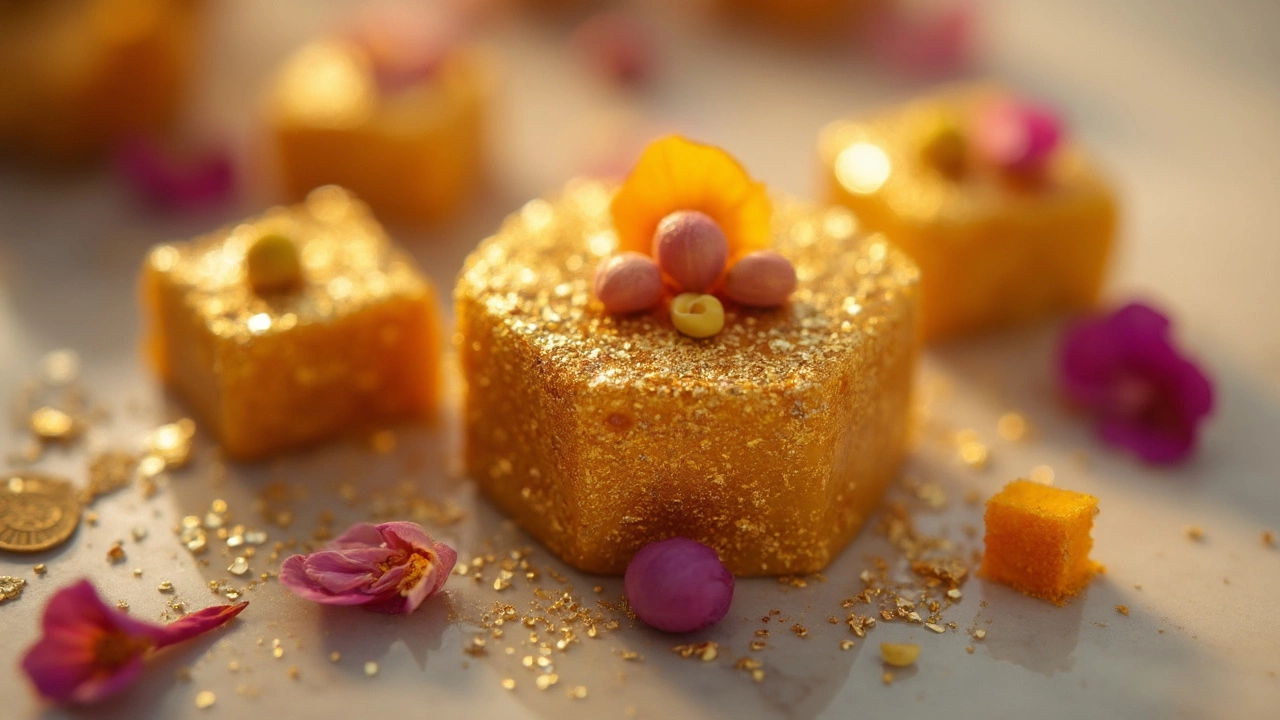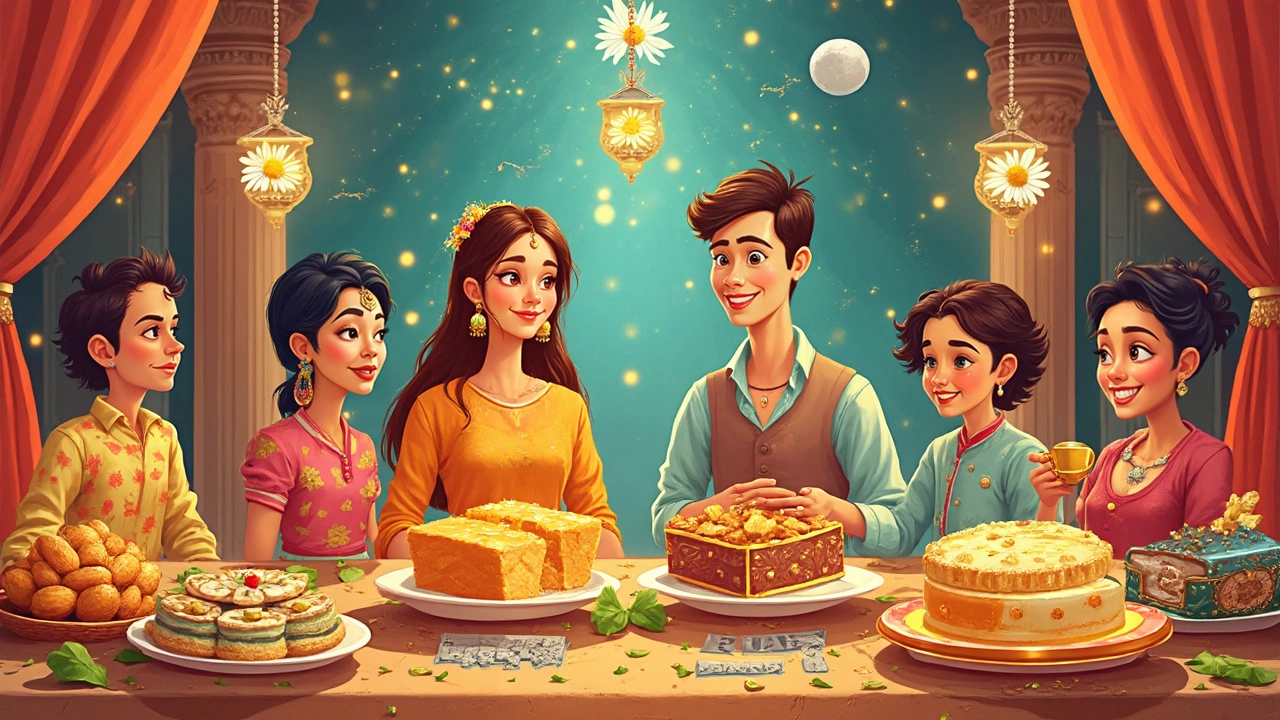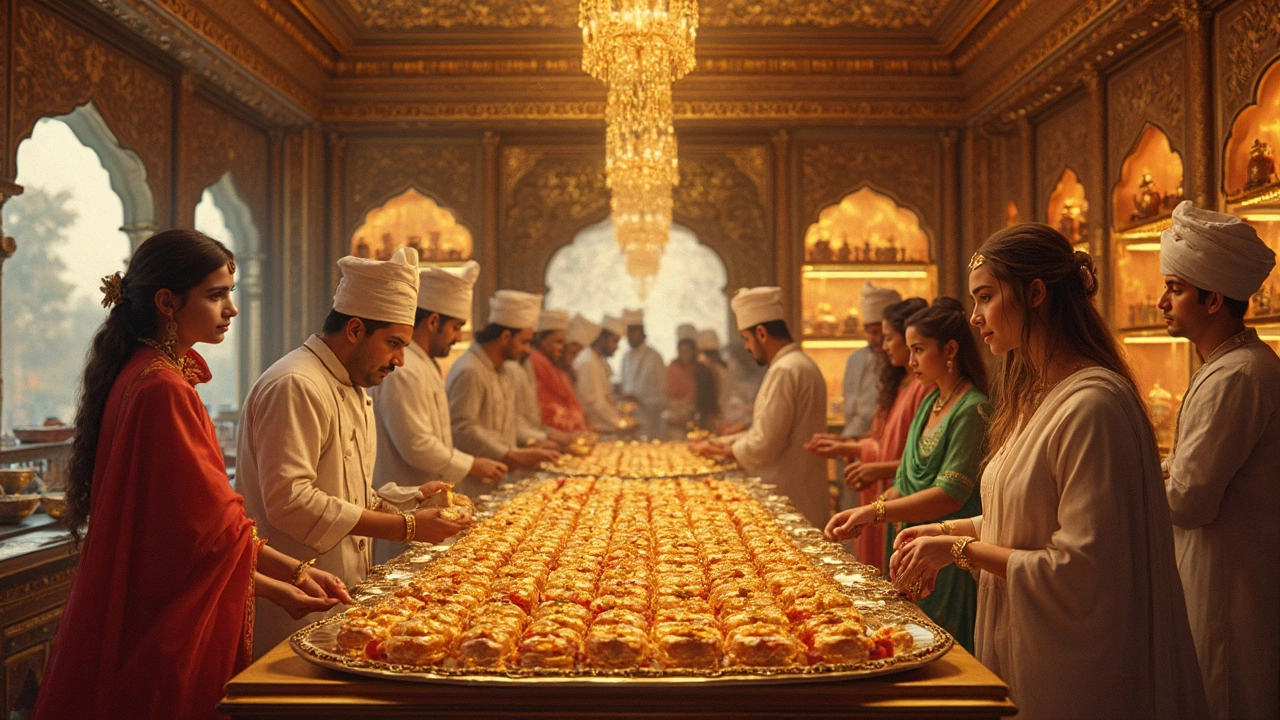If you thought Indian sweets were just about gulab jamun or rasgulla, think again. The world of mithai has its own luxury segment, and some treats literally come coated in gold. The most expensive sweet dish in India? That title goes to the legendary Golden Pista Barfi.
This isn’t your regular barfi from the corner shop. Imagine rich pistachio fudge, scented with saffron, studded with Iranian nuts, and topped with actual 24-karat edible gold. One box can cost as much as a high-end phone, sometimes stretching into thousands of rupees for just a few pieces. It’s the kind of mithai you’d spot at ultra-posh weddings or in a celebrity’s Insta story—not your average Diwali giveaway.
These sweets aren’t just pricey for the sake of it. The ingredients read like a shopping list from a luxury import store—think Sicilian pistachios, Himalayan saffron, organic honey, and of course, sheets of real gold that are safe to eat. Some places even offer limited boxes, making them feel exclusive, almost like edible jewelry.
- The Real Priciest Sweet: Golden Pista Barfi
- What Makes Golden Pista Barfi So Expensive?
- The Art of Making Luxury Mithai
- Other Ultra-Premium Indian Sweets
- Tips for Trying or Making Luxurious Sweets
The Real Priciest Sweet: Golden Pista Barfi
If you ask around about the priciest Indian sweet, one name pops up over and over—Golden Pista Barfi. This treat has made headlines for its crazy price tag and its even crazier ingredients list. Boxes can range from ₹7,000 to over ₹20,000 a kilo, depending on where you buy it and what’s inside. At outlets like Chhappan Bhog in Lucknow and The Royal Plaza in Delhi, the barfi is stacked in boxes like precious gems, not like regular mithai.
This mithai isn’t solely about flash. What makes Golden Pista Barfi so exclusive is its use of premium pistachios (often imported), top-notch saffron threads, pure ghee, and a layer of 24-carat edible gold. Sometimes, you’ll find it garnished with rare nuts or even dusted with silver vark, but it’s the gold sheet that really pumps up the price.
The attention to detail is no joke. Every piece is hand-shaped, making sure the gold leaf looks flawless on each bite. Makers say it’s not just about taste; it’s about the experience of eating something reserved for royalty, maharajas, or anyone wanting to celebrate in style. Most people end up seeing this sweet on social media or luxury food blogs because it’s just not something you stumble upon in a regular sweet shop.
So what does most expensive sweet dish in India actually taste like? Reviews are usually big on the nutty richness and the smooth texture. However, let’s be real: gold doesn’t add flavor—it’s the bling factor that makes all the difference. If you’re looking for show-stopper mithai, Golden Pista Barfi is as over-the-top as it gets.
What Makes Golden Pista Barfi So Expensive?
So, what’s behind the crazy price tag on Golden Pista Barfi? It’s not just some marketing trick. The cost comes down to rare and fancy ingredients, how much effort it takes to make each piece, and the show-off factor that comes with the gold itself.
First up: the nuts. Most Indian sweets use regular pistachios, but the barfi that stands out goes for top-grade pistachios from Iran or Sicily. They’re more buttery, super green, and cost up to five times more than the basic stuff you’d find in most mithai shops.
Then you’ve got saffron. Not all saffron is the same—a gram of good-quality Kashmiri or Iranian saffron can cost more than ₹500. Each strand is hand-picked, and a box of Golden Pista Barfi packs in more than just a pinch for flavor and color.
Now for the wildest part—the edible gold. Shops use food-safe 24-karat gold leaf, and honestly, you’re paying a lot for that luxury vibe. Gold leaf isn’t cheap. Just a sheet of it can cost ₹1000-1500, and lots of pieces are covered in more than one. On top of that, the sweets are often boxed in custom packaging with intricate designs, adding to the final bill.
- Most expensive sweet dish in India uses only premium imported ingredients.
- Real 24-karat gold leaf is used—this is safe to eat and is what makes it shiny and instantly Instagrammable.
- Labor isn’t cheap, either. Each barfi is handmade, often by skilled staff used to working for five-star hotels.
- Packing is next level—think velvet boxes, crystal plates, maybe even a mini treasure chest.
Here’s a quick look at what drives up the cost:
| Ingredient/Feature | What Makes It Special | Average Added Cost |
|---|---|---|
| Iranian/Sicilian Pistachios | Unique flavor, higher fat content, vibrant color | ₹2,000/kg (vs ₹500/kg for Indian pistachios) |
| Kashmiri/Iranian Saffron | Deep aroma, intense color | ₹500-700/gram |
| Edible 24k Gold Leaf | Luxury look and feel | ₹1,200/sheet |
| Specialized Packaging | Custom, imported, or handcrafted boxes | ₹500-1,500/box |
When you wrap it all together, Golden Pista Barfi isn’t just a sweet. It’s a status symbol, the ultimate gift, and lets someone say, “Hey, my dessert is coated in gold.”

The Art of Making Luxury Mithai
If you’re wondering why Golden Pista Barfi commands such jaw-dropping prices, it all comes down to how it’s made. The process is super fussy—think careful sourcing, big brands behind the counters, and expert halwais who treat mithai like art.
Let’s break it down. The basics start with high-quality pistachios, and not just any kind. The finest kitchens import them from places like Iran or Sicily, where the flavor and color are unbeatable. Next up, real saffron from Kashmir or Spain, which alone can cost thousands per kilo. Even the honey isn’t local—it’s raw, sometimes organic, and often imported for that unique aroma. Every ingredient is tested for purity and taste before it hits the pan.
But that’s just the prep work. When they start making the barfi, the halwais (mithai chefs) use old-school methods—copper pans, slow roasting, and constant stirring by hand. There’s no cutting corners here. Some kitchens claim it takes up to twelve hours from start to finish, mostly because luxury sweets need that rich, melt-in-the-mouth texture. Any shortcuts? The batch is rejected.
Now comes the real showstopper: edible gold. The gold sheets used for the top are about 0.2 microns thick. Enough to look blingy but totally safe to eat (and flavorless). Applying the gold is delicate work. The kitchen staff uses soft brushes and even tweezers. You mess up, you waste gold, and that adds up real quick—some shops say just the gold for one kilo of sweet can cost upwards of ₹70,000.
| Luxury Ingredient | Source/Origin | Estimated Cost per Kilo (May 2025) |
|---|---|---|
| Pistachios | Sicily/Iran | ₹3,500–₹6,000 |
| Kashmiri Saffron | Kashmir/Spain | ₹2,50,000+ |
| Edible Gold Leaf | Global | ₹70,000+ |
| Organic Honey | India/Imported | ₹600–₹1,200 |
After all this, the presentation matters—each piece of most expensive sweet dish in India is packed in hand-crafted boxes, sometimes with customer names engraved. The final touch? Quick delivery with loads of ice packs so it doesn't melt on the way. These sweets aren’t just about taste; they're about the whole experience of luxury and exclusivity.
Other Ultra-Premium Indian Sweets
Golden Pista Barfi might steal the spotlight, but it’s not alone in India’s luxe dessert line-up. There are sweets that get as much attention for their price tags as their flavors. Some of these are sold only by invitation or under tight pre-orders, especially during wedding season or major festivals.
One famous name? The ‘Exotic Motichoor Ladoo’ by a Hyderabad-based sweets shop. These are made with pure saffron strands, pure silver vark (edible foil), and often come with luxury packaging that could rival designer handbags. Prices can go upwards of ₹12,000 per kilo, thanks to carefully sourced ghee and imported almonds.
Then there’s the Royal Kaju Katli, crafted in Mumbai and Delhi. Standard kaju katli is a favorite in every household, but this luxury version uses cashews grown only in Goa, topped with real silver leaves, and sometimes stuffed with pistachio paste. Gift packs for these can cross ₹10,000 during Diwali, especially when wrapped in hand-made boxes.
For people in Kolkata, the ‘King Sandesh’ has become a statement gift. Served with small ruby or emerald stones (yes, real ones for display!), and sprinkled with gold dust, a platter of this sweet once sold for over ₹50,000 at a charity auction.
Why do folks pay so much? It’s not just about taste—these pricey Indian sweets are about luxury, status, and gifting something that stands out. Here’s a quick peek at how much these treats can cost in high-end mithai stores:
| Sweets | Special Ingredient | Approximate Price (₹ per kg) |
|---|---|---|
| Golden Pista Barfi | 24k Gold leaf, Sicilian pistachios | 15,000 - 20,000 |
| Exotic Motichoor Ladoo | Saffron, Silver vark | 12,000+ |
| Royal Kaju Katli | Goan cashew, Pistachio paste | 10,000+ |
| King Sandesh | Gold dust, Gemstone topping | 50,000 (per tray) |
The most expensive sweet dish in India isn’t just about taste—it’s about rare ingredients, presentation, and a good dose of tradition. When you see someone splurging on these, it’s often for a milestone celebration or to make sure their gift is remembered.
- If you ever find one of these sweets at a party, try at least a bite—you’ll taste the difference, especially the top-quality pistachios or that subtle hint of saffron.
- Be sure to check for the real gold or silver vark—good shops always use certified edible foil.
- If you’re buying as a gift, always ask for sealed and well-labeled boxes. Authentic luxury mithai brands are transparent about their ingredients and pricing.

Tips for Trying or Making Luxurious Sweets
Sneaking a taste of the most expensive sweet dish in India isn’t something you do every day, but you can get close. Whether you want to buy it or try whipping up a homemade take, there are a few things you should know before you jump in.
If you’re thinking of buying, always go to a trusted sweet shop with a reputation for quality. Brands like Chhappan Bhog, Puranmal, and Khoya have all offered gold-plated pista barfis or similar luxury sweets. Don’t expect them to be sitting in the display though—many require advance orders, especially if you want them with those extra bells and whistles like imported nuts and saffron. At weddings and high-end parties, luxury sweets are often displayed with price tags as high as ₹20,000–₹25,000 per kilo.
Want to try your hand at making something similar at home? Here’s a simple breakdown:
- Skip the gold leaf if you’re on a budget, but don’t skimp on real Kashmiri saffron and fresh pistachios. Both make a huge difference to flavor and look.
- Look for edible gold leaf online—brands like Zarda and Connoisseurs offer food-grade options. Usually, you'll need just one sheet for a small tray.
- Stick to good-quality condensed milk, and if possible, use organic sugar or honey for a richer taste.
- Always chill luxury sweets before serving. The flavors come through better, and the gold leaf sticks nicely.
Here’s a quick table showing the cost difference between regular barfi and its luxury cousins:
| Type | Main Ingredients | Approximate Cost (per kg) |
|---|---|---|
| Regular Pista Barfi | Pistachio, Milk, Sugar | ₹800 – ₹1200 |
| Luxury Golden Pista Barfi | Pistachio, Kashmiri Saffron, Edible Gold, Imported Nuts, Organic Sugar | ₹20,000 – ₹30,000 |
If you’re gifting, wrap them up in minimalist boxes with dry ice packs—nobody wants melted gold. And if you’re making them yourself, make a small batch first. It’s easy to go overboard, especially with premium ingredients.
Trying or making luxury sweets is definitely a flex, but with the right stuff (and some patience), you might surprise yourself and your family. I once spent a small fortune sourcing edible gold for an anniversary barfi for Arjun, and while my bank balance wasn’t thrilled, the look on his face was worth every rupee.
